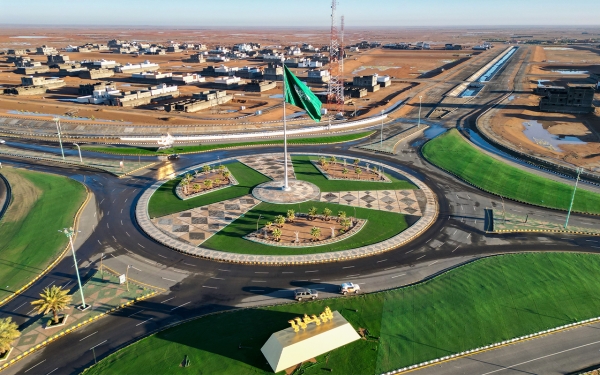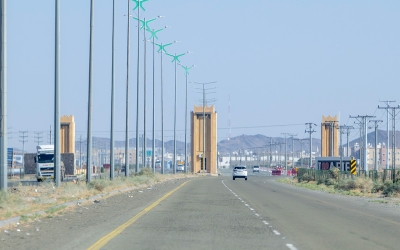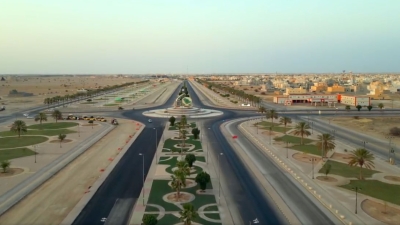

Al-Khurmah Governorate (romanized: Muḥāfad͟hat al Khurmah) is one of the governorates of the Makkah al-Mukarramah Province, located in the west of the Kingdom of Saudi Arabia. It is considered the fifth smallest governorate in the province in terms of population. According to the 2022 Saudi Census, only 0.5 percent of the province's population resides there, estimated at 38,744 thousand individuals.
Administratively, al-Khurmah is classified as a Category (A) governorate and consists of four administrative centers: al-Ghareef Center, Abu Marwah Center, Dhaleem Center, and al-Khabra Center.
Designation of al-Khurmah
The name al-Khurmah originates from the natural environment in which it is located. It is named after the narrow passageways amidst dense vegetation or otherwise, called Khrima. The city developed around this Khrima or passage, hence the name, and its strategic location between the Najd and Hijaz regions earned it a reputation as a commercial hub. Convoys traveling from Yemen and the southern Arabian Peninsula, heading to the Levant and vice versa, would pass through it. Some sources also suggest that the name might be derived from a plant that used to grow there, which grows to a height ranging between thirty to sixty cm and has a pleasant taste.
Location of al-Khurmah Governorate
Al-Khurmah Governorate (the governorate's headquarters) is located in the southeast of Makkah al-Mukarramah Province, about three hundred km east of Makkah al-Mukarramah city, the headquarters of the Emirate, and covers an area of 20,800 km².
Al-Khurmah Governorate terrains
Al-Khurmah Governorate boasts diverse terrains compared to other governorates of the Kingdom, including lava fields, mountains, valleys, and streams where freshwater springs flow, as well as sand dunes in its northern part, known as the Subay Desert. These are similar to the dunes in ar-Rub' al-Khali Desert, with golden sands through which the streams of Wadi Subay flow, descending from the Sarawat Mountains in the south.
Economic activities in al-Khurmah Governorate
The inhabitants of al-Khurmah engage in agriculture, with a particular focus on date palm cultivation. The governorate is known for its varieties of dates like Safri, Sari, Duqul, Sulj, Khudri, and Humri, and it is also renowned for its citrus, grapes, and alfalfa (Medicago sativa) agriculture, as well as other crops like brown wheat, corn, and barley.
Due to the scarcity of water and its limited availability, citizens turned to trade, and various commercial activities spread throughout the governorate. The location of these businesses along the pilgrimage route added significant importance to them. Pilgrimage convoys coming from the southeastern regions, including Wadi al-Dawasir, Bisha, and Oman, would gather in these areas, making them essential rest stops for the convoys.
Services in al-Khurmah Governorate
Taif International Airport, about 202 km away from al-Khurmah Governorate, is the nearest airport. It has a capacity of approximately 550 thousand passengers annually.
The governorate can be accessed via al-Khurmah-Rania-Bisha road, a dual carriageway stretching 360 km with two lanes in each direction.
Several industrial establishments are present in the governorate, including the Ad-Duwayhi gold mine, al-Suq gold mine, and a central electricity generation station.
Historical sites in al-Khurmah Governorate
Al-Khurmah Governorate has a rich historical presence with numerous ancient monuments, historic forts, and natural landmarks, especially in the lava field east of the governorate inhabited by the tribe of Banu Hilal. Their relics still exist, consisting of forts, stone circles, observatory towers, horse stables, and war fortifications known to the locals as Zaraib. These structures contain carvings and ancient drawings.
Among the historical landmarks in the governorate, there are many ancient relics, including stone buildings. These consist of closely packed circular and square stones, meticulously constructed ancient forts, horse stations, and defensive structures placed at the highest point to monitor livestock in the valleys during grazing and to protect them from aggressors. They also contain old inscriptions, writings, and drawings of animals that once inhabited the region.
The governorate also houses al-Musaher Castle in al-Ghreef Center, which is a four-m-high clay tower. It was built by a group from the Subay tribe about 350 years ago and was formerly used for surveillance, shooting, and protecting the region from invaders. In al-Ghreef, there are also old stone-lined wells. Previously, al-Ghreef was known as the Orchard of Banu Amer due to its intense cultivation, diverse crops, fertile soil, and water abundance.
The historical landmarks in al-Khurmah Governorate also include ancient palaces, such as Buqairan Palace in al-Dughmiyah, relics of Hawqan, al-Mu'ayzilah, and the village of al-Salamiyah. Among its ancient markets, the old market in the center of the governorate stands out, in addition to the livestock market.
Related quizzes
Related articles

